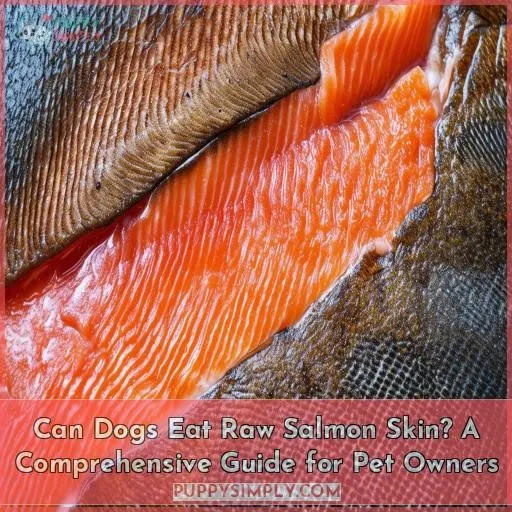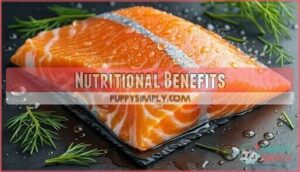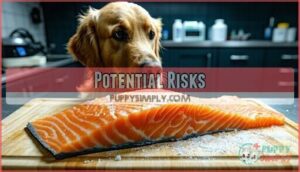This site is supported by our readers. We may earn a commission, at no cost to you, if you purchase through links.
 You can give your pup raw salmon skin, but caution is advised.
You can give your pup raw salmon skin, but caution is advised.
It’s packed with beneficial omega-3s and protein, but also carries risks like parasites and allergies.
Freeze or cook the skin thoroughly to kill any critters, and start with small portions to confirm Fido’s tummy can handle it.
If he has any adverse reactions, consult your vet immediately.
Want to explore the pros, cons, and proper prep methods in more detail?
Table Of Contents
Key Takeaways
- Unleashing the raw power of salmon skin in your pup’s bowl is like navigating treacherous waters – tread carefully and heed the guidance of your trusted sea dog (veterinarian) to avoid potential pitfalls like pesky parasites and rogue allergic reactions.
- While the omega-3 riches and protein payload of salmon skin make it a nutritional treasure trove for your furry first mate, overindulging could lead to a mutiny in your dog’s digestive quarters, so practice moderation and balance as you would when charting any new course.
- Whether you freeze, dehydrate, or cook the salmon skin, proper preparation is key to ensuring your canine crew enjoys the spoils without any unwanted stowaways or scrapes along the way.
- At the end of the day, while an occasional salmon skin treat can be a delightful indulgence, your pup’s overall diet should remain a well-balanced, nutrient-rich voyage, with variety as the spice that keeps their taste buds and health on an even keel.
Can Dogs Eat Raw Salmon Skin?
Yes, dogs can eat raw salmon skin in moderation as an occasional treat. However, raw salmon skin may contain parasites and can be difficult for dogs to digest, so it’s generally recommended to cook or dehydrate the salmon skin before feeding it to your dog.
Nutritional Benefits
Raw salmon skin can be a nutritious treat for dogs, as it’s an excellent source of omega-3 fatty acids that promote healthy skin and coat, and it provides a concentrated dose of protein to support muscle development. However, it’s essential to make certain the salmon skin is fresh and properly prepared to minimize potential risks like parasites or digestive issues.
Omega-3 Fatty Acids
You’re prudent to ponder salmon skin’s omega-3 fatty acids for your pup. These imperative nutrients offer:
- Heart health benefits from DHA and EPA
- Anti-inflammatory properties to ease discomfort
- Improved cognitive function and eye development
- Skin and coat nourishment for a glossy look
Omega-3s make salmon skin a true superfood for dogs. Just be mindful of proper portions.
Protein Source
Salmon skin is packed with nutrient-dense proteins, boasting high bioavailability and essential amino acids fundamental for muscle growth and lean body mass maintenance in dogs. Its abundance in these valuable proteins makes raw salmon skin a potential protein powerhouse, offering pet owners a natural, nutritious option to support their furry friend’s overall health and well-being.
Vitamin Richness
In addition to its protein content, salmon skin is rich in vitamins that support your dog’s overall health. It contains:
- Vitamin A for vision, immune function, and skin/coat
- Vitamin D for bone strength and calcium absorption
- B vitamins for energy metabolism and nervous system
- Antioxidants like vitamin E to protect cells from damage
Providing a well-rounded array of nutrients, salmon skin can be a valuable addition to your pup’s diet when consumed in moderation.
Potential Risks
While raw salmon skin can be a nutritious treat for dogs, it’s essential to be aware of potential risks. Consuming raw fish can expose your pet to parasites like salmon flukes, digestive issues due to the tough skin, and even allergic reactions in some cases.
Parasites
While salmon skin offers nutritional benefits, you should be aware of potential parasites. Tapeworm infections, roundworm transmission, and Salmonella contamination are risks with raw fish. Anisakis larvae and liver flukes can also be present. Consider these risks carefully:
| Parasite | Risk | Preventive Measure |
|---|---|---|
| Tapeworms | Intestinal infection | Freeze salmon properly |
| Roundworms | Larvae transmission | Cook salmon thoroughly |
| Salmonella | Food poisoning | Practice good hygiene |
| Anisakis | Larvae infection | Avoid undercooked fish |
Always weigh the pros and cons for your dog’s health.
Digestibility
You may have concerns about your dog’s ability to digest raw salmon skin. While it contains valuable fiber, the tough texture and lack of digestive enzymes can make it challenging for some dogs to break down fully. Improperly chewed pieces could cause gastrointestinal issues or inflammation. Monitor your pup’s gut health when introducing new proteins.
Allergies
You should also be aware that some dogs can have allergic reactions to salmon. Cross-reactivity between fish and other proteins can cause skin irritation or even anaphylaxis due to histamine release. If your pup shows signs like itching, hives, or breathing difficulties after eating raw salmon skin, consult your vet immediately.
Preparation and Cooking
Before feeding your dog raw salmon skin, it’s essential to prepare it properly to reduce potential risks. Freezing the salmon skin for a specific duration eliminates any parasites, while dehydrating or cooking it using appropriate methods can improve digestibility and prevent potential allergic reactions.
Freezing
You can safely freeze raw salmon skin to extend its shelf life. Freeze individually portioned pieces wrapped tightly in plastic or vacuum-sealed bags to prevent freezer burn. When ready to serve, thaw overnight in the refrigerator. Refreezing thawed salmon skin isn’t recommended, as it increases bacterial growth risks and compromises quality.
Dehydrating
Dehydrating salmon skin is another preservation technique that extends its shelf life. Some pet owners dehydrate salmon skin to create crunchy, long-lasting treats or toppers for their dog’s meals. While dehydrating kills bacteria, it’s crucial to follow proper dehydration methods and store the dried treats properly to prevent spoilage or contamination. Explore alternative dehydrated treats as well for variety.
Cooking Methods
If you prefer cooked salmon skin for your pup, skin removal before cooking is recommended. Boiling or steaming skins prevents excessive oil and fat. Portion sizes are essential – treat skins as an occasional snack, not a meal. Guarantee safe handling by cooking thoroughly to eliminate potential parasites or bacteria.
Moderation and Portion Control
While salmon skin can provide nutritional benefits for dogs, it’s vital to exercise moderation and maintain a balanced diet. Consult your veterinarian for personalized portion guidelines, as excessive consumption may lead to digestive issues or unwanted weight gain.
Treat Guidelines
While raw salmon skin offers nutritional value, it should be treated as an occasional reward, not a dietary staple. Limit portions to avoid overfeeding, and consider dehydrated or cooked salmon skin for training treats. Monitor your dog’s calorie intake, accounting for the high fat and protein content. With moderation, salmon skin can provide health benefits when used strategically.
Balanced Diet
While occasional raw salmon skin treats are fine, you’ll want to ascertain they don’t replace a balanced, nutritious diet. Introduce new proteins gradually, monitor for food allergies, and consult your vet about proper portion sizes. Remember, variety aids nutrient absorption and digestive enzymes, promoting overall skin and coat health.
Consulting a Veterinarian
While raw salmon skin can offer nutritional benefits for dogs, it’s essential to consult your veterinarian before incorporating it into your pet’s diet, as they can assess individual health considerations and monitor for any potential adverse reactions. Your vet’s expertise will guarantee your furry friend enjoys this treat safely and as part of a balanced dietary plan.
Individual Health Considerations
While raw salmon skin can be nutritious for many dogs, you’ll want to consult your vet first, considering:
- Your pup’s age (puppies and seniors may have different needs)
- Any underlying health issues or weakened immunity
- Potential breed predispositions or sensitivities
Every dog is unique, so personalized guidance guarantees you make the safest, healthiest choice.
Monitoring for Adverse Reactions
Even if you think the salmon skin is safe, closely monitor your dog for any adverse reactions. Watch for allergic symptoms like itching, hives, or difficulty breathing. Also, look out for gastrointestinal issues like vomiting or diarrhea. If you notice any concerning signs, stop feeding the salmon skin and consult your vet immediately.
Frequently Asked Questions (FAQs)
Are there any dog breeds that shouldnt eat salmon skin?
Small breeds or puppies may struggle to digest salmon skin, so it’s wise to limit or avoid it. Larger dogs can usually handle it, but monitor for issues like vomiting or diarrhea. When in doubt, consult your vet for specific advice on your pup’s diet.
Can puppies safely consume raw salmon skin?
Puppies have delicate digestive systems, so giving them raw salmon skin could be like playing with fire. While small amounts may be okay occasionally, it’s safer to stick to puppy-formulated foods to avoid any hiccups in their growth and development.
How often is it safe to feed salmon skin?
Feed salmon skin in moderation – once or twice a week at most. Too much can cause digestive issues and nutritional imbalances for your pup.
Are there alternatives to raw salmon skin for dogs?
As a symbol of nourishment, fresh salmon offers abundant nutrition for pups. Yet, cooked fish skins like chicken or beef provide safer, fiber-rich alternatives without potential parasites or bones that could harm your furry friend’s digestive tract.
Does the type of salmon matter for its skin?
Yes, the type matters. Wild-caught salmon has fewer contaminants, while farmed salmon may contain chemicals from feed. Always opt for fresh, responsibly sourced salmon skin for your pup.
Conclusion
Like traversing treacherous waves, deciding whether raw salmon skin is suitable for your canine companion requires diligent deliberation.
While its omega-3s and protein provide nutritional advantages, the perils of parasites and allergies necessitate caution.
By preparing it appropriately through freezing, dehydrating, or cooking techniques, and observing your dog’s reaction, you can cautiously explore whether raw salmon skin aligns with Fido’s dietary needs.
Consulting your veterinarian remains paramount for specific guidance on incorporating this piscatorial treat.












